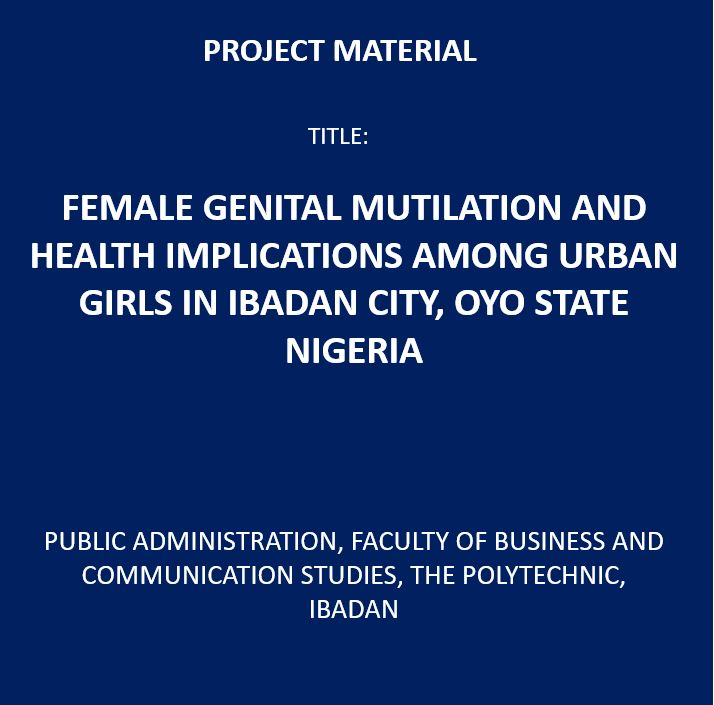No products in the cart.
Female Genital Mutilation and Health Implications Among Urban Girls in Ibadan City, Oyo State, Nigeria
₦10,150.00
FEMALE GENITAL MUTILATION AND HEALTH IMPLICATIONS AMONG URBAN GIRLS IN IBADAN CITY, OYO STATE NIGERIA
- NUMBER OF PAGES: 59
- FILE TYPE: DOC - CHAPTER 1-5
- DEGREE: HND
- DEPARTMENT: PUBLIC ADMINISTRATION, FACULTY OF BUSINESS AND COMMUNICATION STUDIES, THE POLYTECHNIC, IBADAN
Background to the Study
The practice of Female Genital Mutilation (FGM) is regrettably persistence in many parts of the world. This occurs commonly in developing countries where it is firmly anchored on culture and tradition, not minding many decades of campaign and legislation against the practice (Onuh et al., 2006; WHO, 2008) me female genital mutilation comprises any procedure involving partial or total removal of the external female genitalia or other injury to the female genital organs for cultural, religious or other non-therapeutic reason (WHO, 2008). The World Health Organization (WHO) estimates that between 100 and 140 million girls and women worldwide are presently living with female genital mutilation and every year about three million girls are at risk (WHO, 2008). In Africa, it is estimated that about 92 million girls from 10 years of age and above all other gun female genital mutilation (WHO, 2010).
Female Genital Mutilation (FGM) is described by the World Health Organization (WHO) as all procedures which involve partial or total removal of the external female genitalia and/or injury to the female genital organs, weather for cultural or any other non-therapeutic reasons. In Nigeria, subjection of girls and women to obscure traditional practices is legendary. Female genital mutilation is an unhealthy traditional practice inflicted on girls and women worldwide. Female Genital Mutilation is widely recognised as a violation of human rights, which is deeply rooted in cultural beliefs and perceptions over decades and generations with no easy task for change.
Nigeria has the world’s third highest Female Genital Mutilation prevalence. it’s estimated that 25 percent or 19.9 million Nigerian girls and women 15 to 49 old years underwent FGM/C between 2004 and 2015 (UNICEF, 2016). These absolute numbers are only thought of Egypt’s 27.2 million victims and Ethiopia’s 23.8 million (UNICEF, 2016). Female Genital Mutilation is widely practised in many Nigerian cultures and is considered important for women’s socialization, curbing their sexual appetites and preparing them for marriage. According to Bodunrin (1999), Female Genital Mutilation is defined simply as a cultural publication and cleansing rite, with people describing it as female circumcision, believing it an equivalent of male circumcision. Mockery, loss of respect, and reduced marriage offers are social sanctions against not circumcised females in Nigerian cultures where FGM/C is practiced (Bodunrin, 1999).
Female genital mutilation (FGM) is a procedure which causes a number of health problems for woman and girls. There is a great deal of evidence indicating extremely detrimental long and short term health consequences (UNICEF 2002). The procedure has no health benefits for girls and women. Adverse consequences of FGM a shock from pain and hemorrhage, infection, acute urinary retention following such trauma, damage to the urethra or anus in the struggle up the victim during the procedure making the extent of the operation detected in many cases by chance, chronic pelvic infection, acquired gynatresia resulting in a hematocolpos, vulval adhesions, dysmenorrhea, retention cysts and keloids, and sexual dysfunction. (Ajadi, 2016) However, despite the cultural justifications for the practice, as in many other countries, evidence in Nigeria of declining levels of FGM/C is supported by almost monotonic increase in the proportion of women circumcised, from oldest to youngest age cohorts. The proportion of circumcised women decreased from 35.8% among women ages 45 to 49 to 15.3% (NPC Nigeria and ICF International 2014). Despite decreasing support for the practice, however, millions of girls remain in considerable danger of being circumcised. The UNICEF report reveals that a majority of people in most countries where the practice is concentrated oppose it, yet about 30 million girls are still at risk of being cut in the next decade (UNICEF 2013).
The findings of UNICEF (2015) gave the national prevalence of Female Genital Mutilation (FGM) of 61% among Yoruba, 45% among Igbo and 1.5% among Hausa-Fulani ethnics group, this making it a greater problem in southern Nigeria. Oyo state is one of the States in southern Nigeria therefore one May assume that female genital mutilation (FGM) also occurs there. However, the authenticity of this claim is not known as there have not been many studies done to check if actually female genital mutilation (FGM) exists in Oyo State. This study therefore intends examine Female Genital Mutilation (FGM) and health implications among urban girls in Ibadan City, Oyo State, Nigeria.
- ₦10,150.00






